Landscaping in Jasper National Park
Jasper National Park
- Planting guidelines - Town of Jasper (PDF, 898 KB)
- Planting list - Outside the Jasper townsite (PDF, 628 KB)
Landscaping in the Town of Jasper
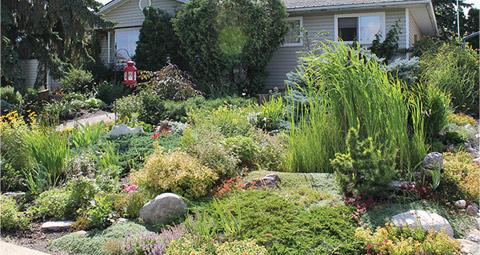
Jasper’s urban landscape is an important part of the town's character while contributing to the surrounding protected National Park wilderness with minimal environmental and cultural resource impacts. This urban landscape includes the vegetated areas (including trees, shrubs and other plantings) in both public space and on private leaseholds, as well as the natural open space within the townsite. While this landscape will support a wide variety of plant material, native plantings, that have minimal wildlife attractants, and support FireSmart principles will be the priority for landscaping and landscape plans.
Maintaining a community’s collective landscaping benefits the environment, the health and wellbeing of residents, and creates beautiful spaces for all to enjoy. The Architectural Motif Guidelines for the Town of Jasper sets out general guidelines and the Town of Jasper Land Use Policy contains requirements such as maintaining a minimum amount of soft landscaping (vegetative) for each zoning district. Landscaping, including excavation or terrain manipulation, requires a Parks Canada Development Permit. Click the following Link to learn more about the landscaping requirements of your zoning district and apply for a Parks Canada Development permit for Landscaping.
The following information is intended to assist you in planning your soft landscaping (vegetative) project for permit or provide you guidance in replacing existing plantings with suitable native species alternatives. If you are planning a landscaping project outside of the town site, please see “Landscaping in Jasper National Park”.
Landscaping outside the Town of Jasper
Jasper’s landscape is an important part of its character and it is critical that outlying commercial accommodations and cottages blend into the surrounding protected National Park wilderness with minimal environmental and cultural resource impacts. The ecosystem will support a wide variety of plant material but native plantings, that have minimal wildlife attractants and support FireSmart Canada principles, are required in these special areas. With the exception of annual plantings and golf course greens, any new or replaced vegetation must be native to the National Park.
Maintaining native landscaping benefits the environment, the health and wellbeing of visitors, and creates beautiful spaces for all to enjoy. The Outlying Commercial Accommodation and Hostels in the Rocky Mountain National Parks contain landscaping requirements. All landscaping, including vegetation removal, excavation or terrain manipulation, requires a Parks Canada Development Permit. Click the following link to learn more about the landscaping requirements and apply for a Parks Canada Development permit for Landscaping.
The following information is intended to assist you in planning your soft landscaping (vegetative) project for a permit or provide you guidance in replacing existing plantings with suitable alternatives.
Vegetation removal, excavation or terrain manipulation
A Parks Canada Development Permit is required before any work commences. Ground excavation and terrain manipulation (including small tree/shrub removal), are considered disturbances on the protected landscape.
Mature tree retention or removal
Mature trees (at least 20 cm diameter at chest height) are important to the ecosystem and should be retained, unless they are a significant FireSmart hazard or wildlife attractant. They filter air and water, help control storm water, provide protection from wind, shade in summer, screen for privacy, and provide critical wildlife habitat. If your mature tree must be removed for development, or it is assessed as a hazard, you will be required to obtain a Parks Canada Tree Removal Permit. Where mature trees must be removed, replacement trees will need to be planted at a ratio of at least 1:1. This will be assessed on a case-by-case basis.
Bird nests are protected at all times
Tree removal should be done before or after the bird nesting period. Parks Canada is required under the Migratory Bird Act to protect nesting birds from April 21 to August 13. Therefore, your application may be restricted during this time. Danger trees (those that pose hazard to property, infrastructure and/or public safety) assessed by a certified arborist can be removed during the nesting bird period with a Tree Removal Permit. It is, however, expected that leaseholders plan to do tree removals outside this period, except in emergency circumstances.
If you find an active nest in a tree you wish to remove, outside of the nesting bird period, you must contact Parks Canada: jasperrealtymunicipalservices@pc.gc.ca and refrain from removing the tree.
There may be extenuating circumstances where a tree must be removed during the bird nesting period. These exceptional circumstances are rare, but may be granted with additional mitigations applied. At a minimum, the proponent would need to enlist the services of a registered, licenced professional biologist to do a full inspection of the tree to ensure the absence of nesting birds. If none are found, a permit may be issued.
Parks Canada tree removal permit
To apply for a Parks Canada Tree Removal Permit you will need to fill out a Parks Canada Tree Removal Application including:
- a completed Parks Canada Tree Removal Application
- tree species and number of trees
- purpose of removal. If considered hazardous, a written danger tree assessment from a certified danger tree assessor with proof of their certification is required
- photo(s) of the tree(s)
- dimensioned site plan illustrating the location of the tree(s), structures, and lot lines on the leasehold
- flag the tree(s) of concern with flagging tape
Leaseholder Authorization
If you are applying on behalf of the leaseholder of the property, please also include a signed copy of the Leaseholder Authorization Letter (PDF, 58 KB).
Application to Remove 10 Trees or Less
If you are removing 10 trees or less, please use this application form. (PDF, 350 KB).
Application to Remove More Than 10 Trees
If you are removing more than ten trees, please use this application form (PDF, 395 KB).
Harvesting and landscape plan
Please be advised that, should there be more than 10 trees cut down, a harvesting and landscape plan will be required. The following elements should be included in your plan, at a minimum:
- a written detailed description of and the proposed project
- indication of any proposed tree removal
- drawings of (a) what currently exists in the proposed work area with dimensions in metric and; (b) the proposed project with dimensions in metric
- a list of species to be planted, with common and scientific names
- additional information may be requested
Space permitting, contractors and leaseholders are expected to replace, at a minimum, the same number of trees that were removed. In some cases, it may be more. Refer to the attached Town of Jasper Planting List for allowable plant species.
Once the form is completed and the tree(s) are flagged, please return the application and supporting documents to jasperrealtymunicipalservices@pc.gc.ca. Please allow 10 business days to process your Tree Removal Permit.
If tree removal is related to development on property
If tree removal on the property is related to an ongoing development project (within 3 metres of the development), you do not need to apply for a Tree Removal Permit as removal will be included in your Development Permit.
General guidelines for planting
Step 1: Where to plant
Follow the zone guidelines set out by FireSmart Canada. The design of the landscape immediately adjacent to buildings is a critical factor in determining the likelihood of an asset being resilient to wildfire impacts.
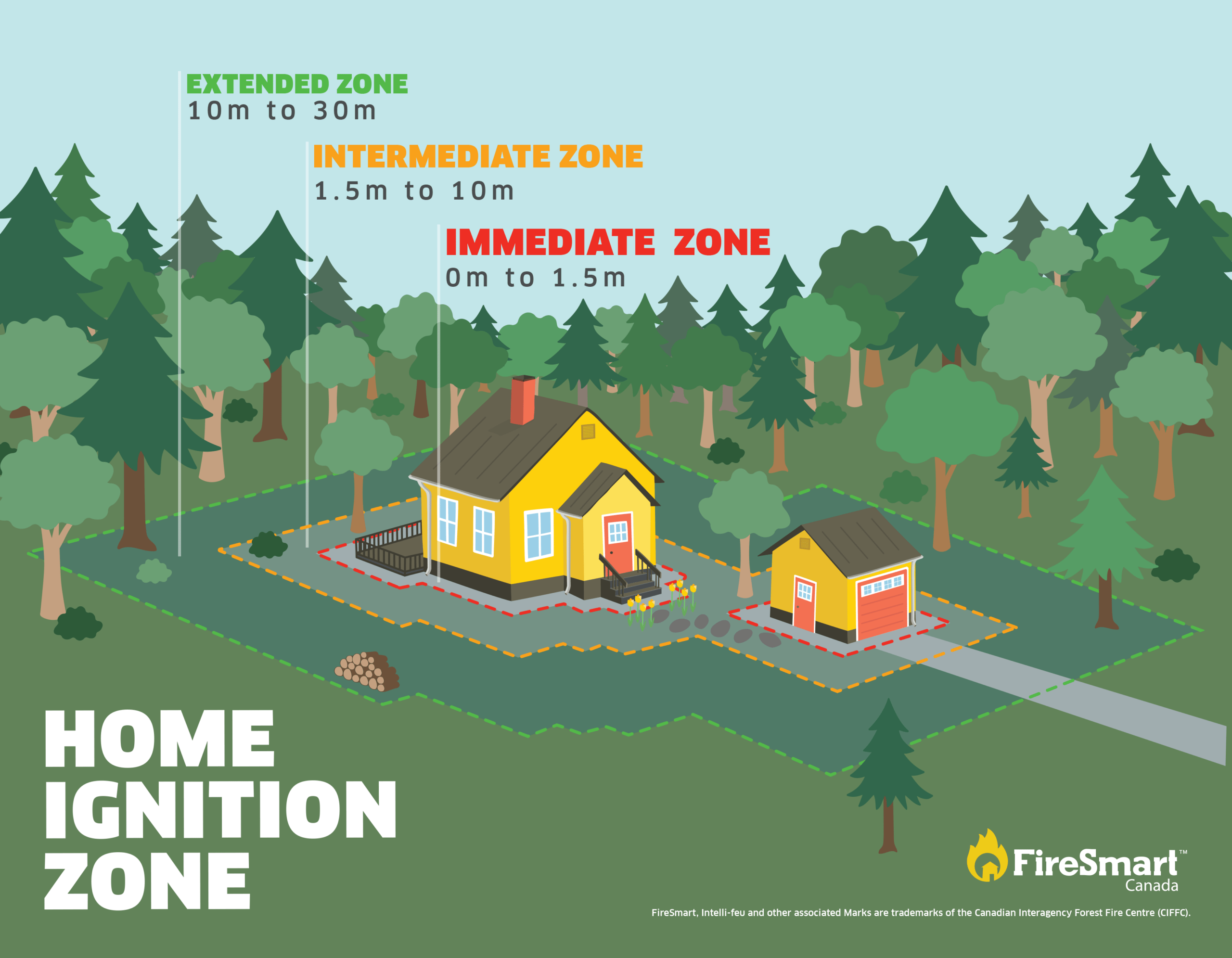
Zones
Immediate zone (0 – 1.5 m from building)
No planting of trees or other woody vegetation or use of mulch in this area.
Intermediate zone (1.5 – 10 m from building)
No planting of coniferous trees in this area. You may plant deciduous native trees like aspen, poplar, cottonwood and birch. This is encouraged.
Landscape with appropriate short grasses, flowers, shrubs, in low density. Do not use bark or pine needle mulches in this zone as they are highly combustible. Gravel mulch and decorative crushed rock mulch significantly reduces the risk of wildfire.
Extended zone (10 – 30 m from building)
Both coniferous and deciduous trees can be planted in this zone. Spacing is important. There should be 3 m between adult coniferous trees, from drip line to drip line (between outer branch tips of each tree). To achieve this, plant saplings/small trees at least 8 m apart.
Deciduous trees can be planted closer together (~4 m). Again, planting deciduous native varieties is preferred over coniferous trees. Wood mulch is not recommended.
Planting near utility lines
If your lot has a formal utility right-of-way, avoid planting trees or shrubs in these areas to ensure unhindered access for future utility installation or maintenance. Trees should be planted a minimum of 5 m from your septic line to mitigate root damage to the service line.
Step 2: Planting considerations
No planting of fruit-bearing trees and shrubs
Fruit-bearing trees and shrubs, such as crab apple trees, plum trees and Saskatoon berry bushes attract wildlife – ungulates and bears – and result in wildlife harm and unacceptable public safety risks. Driven by their keen sense of smell and hearty appetite, bears may lose their shyness around people as they look for calorie-rich foods. Bears can climb into trees in search of ripening food, breaking branches in the process, and getting a food reward that will bring them back repeatedly. This may also lead to a bear seeking other food sources such as garbage or pet food, thereby putting their life at risk.
Plant native species
Jasper Townsite
Native species with low palatability to wildlife should be used for projects in areas of high human use. Invasive non-native plants pose a significant ecological threat to native plant and wildlife communities. They spread rapidly without their natural insect predators and disease controls. They also displace native plant species that stabilize soils and provide forage and cover for wildlife. Personal gardens and built landscapes are entry points for many invasive, non-native plants. The most effective way to control non-native plants is to prevent their establishment.
Vegetable gardens are permitted, aggressive, spreading species (like mint and chives) must be planted in pots as opposed to beds. Vegetables can also attract wildlife, so fencing or screened enclosures is required.
Outside of the Jasper Townsite
Only native species with low palatability to wildlife are allowed for projects outside the townsite of Jasper. Non-native plants pose a significant ecological threat to native plant and wildlife communities. They spread rapidly without their natural insect predators and disease controls. They also displace native plant species that stabilize soils and provide forage and cover for wildlife. Personal gardens and built landscapes are entry points for many non-native plants. The most effective way to control non-native plants is to prevent their establishment. Some common, non-invasive annuals, are permitted for planting in baskets and flower boxes. While these plants will attract the bees and butterflies, most will also be appetizing for elk and deer. Annual plants may include:
- Begonias
- Petunias
- Impatiens
- Geraniums
- Marigold (not palatable for elk and deer)
- Calibrachoas (million bells)
- Ageratum
- Vincas
- Pentas
- Portulaca
- Salvias
Choose low fire risk species
Low flammability vegetation is required for any areas adjacent to facilities or infrastructure. Few coniferous trees are included in the recommended plant list below due to their high flammability rating, which pose a greater fire risk to buildings and communities.
Deciduous trees
Deciduous trees (with leaves) are attractive for ungulates (elk and deer). After planting, the stems of these trees must be protected with cage and stakes to a 2 metre height until they are mature and established enough to withstand ungulate browse. This typically takes 3 – 5 years, depending on the tree/shrub species, its age, and the frequency of ungulate browsing.
Step 3: What to plant
Wherever possible, these plants should be derived from local stocks to reduce the risk of introducing non-native varieties. All species listed are now, or soon to be, available from Alberta sources as seed or plants; they are considered non-invasive and are not at high risk of mortality from disease.
Deciduous trees, particularly aspen poplar (Populus tremuloides), are seeing decreases in the park due to ungulate browsing. We encourage leaseholders to plant these trees in their yards. Similarly, Douglas-fir (Pseudotsuga menziesii) are the preferred coniferous tree for planting, due to their fire-resistant nature.
Permitted trees and shrubs for landscaping in the Town of Jasper
This list contains plant species that are native to Jasper National Park and regional area and unlikely to become ecological problems through cross-pollinating with native plants or spreading into the natural environment. Preferred plant species are those that are native to Jasper National Park. Some non-native species that are not invasive, fruit bearing, and have low flammability may also be acceptable. If you’re unsure whether a species is invasive, please reach out to jasperdevelopment@pc.gc.ca for verification. Also, the website www.abinvasives.ca provides an up-to-date list of invasive species in Alberta, and can be a helpful resource.
Trees and shrubs for landscaping outside the Jasper Townsite
This list contains plant species that are native to Jasper National Park and unlikely to become ecological problems through cross-pollinating with native plants or spreading into the natural environment. Required plant species are those that are native to Jasper National Park.
Jasper Townsite planting list
Jasper Townsite planting list - Trees
| Common name | Scientific name | General maximum height | Site conditions |
|---|---|---|---|
|
Deciduous trees |
|||
| Balsam Poplar | Populus balsamifera | 25 m | Moist sites, open to partial shade |
| Paper Birch | Betula papyrifera | 30 m | Shade intolerant, well drained sandy/silty sites |
| River Birch | Betula occidentalis | 25 m | |
| Trembling Aspen | Populus tremuloides | 30 m | Dry-moist, sunny sites, open forest |
| Maple | Acer spp. | 30 m | Moist. Not all maple species are suitable |
| Spring Snow crabapple | Malus ‘Spring Snow’ | 20 m | Not fruit bearing |
|
Coniferous trees* |
|||
| Alpine Fir | Abies lasiocarpa | ||
| Balsam Fir | Abies balsamea | 25 m | Moist sites, partial shade |
| Jack Pine | Pinus banksiana | 25 m | Native Alberta pine - not native to Jasper |
| Limber Pine | Pinus flexilis | 15 m | Slow growing native Alberta pine - not native to Jasper |
| Lodgepole Pine | Pinus contorta latifolia | 30 m | Dry-moist, sunny sites, open forest |
| Rocky Mt. Douglas Fir | Pseudotsuga menziesii glauca | 40 m | Dry-moist, sunny sites, open forest |
| Tamarack | Larix laricina | 20 m | Wet sites, with poor drainage |
| Western hemlock | Tsuga heterophylla | 40 m | Moist sites, shaded to partial shade |
| Western red cedar | Thuja plicata | 40 m | Cool, moist, shady sites |
| Western Yew | Taxus brevifolia | 5 - 15 m | Moist, sheltered sites |
| White Spruce | Picea glauca | 40 m | Moist to wet sites, open or closed forest |
| Whitebark pine | Pinus albicaulis | 20 m | Slow growing native Alberta pine -endangered species. |
* Coniferous trees should be minimum 10 m distance from buildings.
![]() Most acceptable
Most acceptable
![]() Acceptable
Acceptable
Jasper townsite planting list - Shrubs
| Common name | Scientific name | Site conditions |
|---|---|---|
|
Deciduous shrubs |
||
| Arctive Willow | Salix arctica | |
| Bebb's Willow | Salix bebbiana | |
| Bog or Shrub Birch | Betula glandulosa | Moist and dry sites, adaptable |
| Buckbrush | Symphoricarpos occidentalis | Good tall groundcover |
| Common Lilac | Syringa vulgaris | Many cultivars on market |
| Common Wild Rose | Rosa woodsii (later flowering) | |
| Green alder | Alnus crispa | |
| Meadowsweet | Spiraea betulifolia | Prefers canopy, not very vigorous |
| Mountain or River Alder | Alnus tenuifolia | Prefers moister sites |
| Prickly Rose | Rosa acicularis (earlier flowering) | Most commercial shrub roses are non-native varieties |
| Pussy Willow | Salix discolor | |
| Red Osier Dogwood | Cornus stolonifera | Prefers moister sites |
| Shrubby Cinquefoil | Potentilla fruticosa | Many cultivars on market |
| Smooth Willow | Salix glauca | |
| Snowberry | Symphoricarpos albus | |
| Wolf Willow or Silverberry | Elaeagnus commutata | |
|
Evergreen shrubs |
||
| Kinnikinnick or Bearberry | Arctostaphylos uva-ursi | Good groundcover. No more than 10 plants per site |
![]() Most acceptable
Most acceptable
![]() Acceptable
Acceptable
Jasper Townsite planting list - Wildflowers and grasses
| Common name | Scientific name | Site conditions |
|---|---|---|
| Alpine Aster | Aster alpinus | Full sun to partial shade Dry soil (will not grow well on wet sites) Blooms: June-July |
| Alpine Hedysarum | Hedysarum alpinum | Full sun to partial shade Prefers drier soils, can grow in rocky soils Blooms late May-August |
| Cusick's locoweed (Alpine Locoweed) | Oxytropis campestris var.cusickii | Prefers full sun Well drained soils (soils with sand). Blooms: Late May-August |
| Great Blanket Flower | Gaillardia aristata | Full sun (can withstand heat) Medium to dry soil, well drained soil Blooms: Late May-September |
| Bluebell or Harebell | Campanula rotundifolia | Full sun to partial shade Dry well drained soils. Blooms: June-August |
| Strict Blue-Eyed Grass | Sisyrinchium montanum | Full sun Medium to moist soil conditions Blooms: Late April-July |
| Dwarf Fireweed | Chamerion latifolium | Prefers full sun to partial Well drained soil with high organic matter content Blooms: July-August |
| Canada Goldenrod | Solidago canadensis | Full sun Well drained soil, moderately high organic content Blooms: June-August |
| Common Yarrow | Achillea millefolium | Full sun and well drained soils Does not have a high water requirement Blooms: May-September |
| Cut-leaved Fleabane | Erigeron compositus | Full sun Well drained soil, but adaptable to most soil conditions Blooms: May-July |
| Firefly Coral Bell | Heuchera brizoides | Full sun to part shade Medium moisture well drained soils Blooms: May-August |
| Firefly Coral Bell | Heuchera brizoides | Full sun to part shade Medium moisture well drained soils Blooms: May-August |
| Cordilleran Arnica | Arnica mollis | Partial sun Prefers sandy/loamy soils. Will not grow in clay soils Blooms: June-August |
| Red Columbine | Aquilegia formosa | Full sun to part shade Medium moisture well drained soils Blooms: June to early August |
| Cut-leaved Anemone | Anemone multifida | Medium to full sun Moist, well drained soil Blooms: Late July-August |
| Daylily | Hemerocallis hybrida | Partial shade to full sun Well drained soils with medium organic content Blooms: Late June-August |
| Early Blue Violet | Viola adunca | Partial shade to full sun Moderately dry to moist soils Blooms: May-June |
| White Locoweed | Oxytropis sericea | Full sun Dry soil, can grow in gravely soil Blooms: Late May-July |
| Evergreen Candytuft | Iberis sempervirens | Prefers full sun, tolerates some shade Well drained soils (sandy) Blooms: May-July |
| False Solomon’s Seal | Smilacina racemosa | Partial to full shade Grows best in average to moist soil, well drained soil Blooms: June-July |
| Fireweed | Chamaenerion angustifolium | Full sun. moist Well drained soil (can be difficult to grow at home) Blooms: June-September |
| Garden Phlox | Phlox paniculata | Partial shade to full sun Moist, well drained soil Blooms: July-September |
| Golden Corydalis (Scrambled Eggs) | Corydalis aurea | Partial shade Moist, well drained soils Blooms: May-July |
| Graceful/ Slender Cinquefoil | Potentilla gracilis | Full sun Moist but well drained soils. Excellent winter hardiness Blooms: June-July |
| Yellow Locoweed | Oxytropis monticola | Full sun Dry, well drained soils Blooms: June-August |
| Lindley’s Aster | Aster ciliolatum | Partial shade Moist, well drained soils Blooms: August to late September |
| Northern Bedstraw | Galium boreale | Partial shade Medium-dry to medium-moist soils Blooms: June-August |
| Sweetvetch | Hedysarum boreale | Full sun Well drained loamy soils Blooms: June to late July |
| Sweetvetch | Hedysarum boreale | Full sun Well drained loamy soils Blooms: June to late July |
| Prairie Smoke | Geum triflorum | Full sun Drier soil. Grows well with wild blue flax Blooms: Late May- early August |
| Pasture Sagewort | Artemisia frigida | Full sun Dry well drained soils. Heat tolerant Blooms: July-September |
| Pearly Everlasting | Anaphalis margaritacea | Part shade to full sun Medium drained soils Blooms: Late July-August |
| Prairie Crocus (Pasqueflower) | Pulsatilla patens | Full sun Sandy, well drained soils Blooms: May to early July |
| Prairie Groundsel/ Wooly Groundsel | Senecio canus | Partial to full sun Dry soil. (Low water requirement) Blooms: May-August |
| Prairie Sagewort | Artemisia ludoviciana | Full sun Dry, well drained soils (will not grow well in clay soils) Blooms: Late July to September |
| Small- eaf Pussytoes | Antennaria parvifolia | Full sun or partial shade Loamy or clay soils, grows poorly in sandy soils Blooms: May- June |
| Small- eaf Pussytoes | Antennaria parvifolia | Full sun or partial shade Loamy or clay soils, grows poorly in sandy soils Blooms: May- June |
| Rocky Mountain Goldenrod | Solidago spathulata | Partial shade Medium moisture soil (not very wet or very dry) Blooms: June- September |
| Shining Arnica | Arnica fulgens | Partial shade to sun Moist soil Blooms: Late June to late July |
| Shooting Star | Dodecatheon pulchellum | Partial sun to full sun Organically rich well drained soils Blooms: Late May-July |
| Showy Aster | Aster conspicuus | Partial shade to full sun Dry to moist soil conditions Blooms: July-October |
| Showy Locoweed | Oxytropis splendens | Full sun Well drained to dry soil. Hardy plant (good for rock gardens and exposed sunny gardens) Blooms: Late June-September |
| Slender Blue Beardtongue/ Little Flower Penstemon | Penstemon procerus | Partial to full sun Dry soil. Often found in sandy banks/ gravely soils naturally Blooms: June-August |
| Smooth Fleabane | Erigeron glabellus | Full sun Well drained to moist soil Blooms: June-August |
| Star-flowered Solomon’s Seal | Smilacina stellata | Partial sun Slightly dry to moist soil conditions Blooms: Late May-July |
| Mountain Larkspur | Delphinium glaucum | Shade to sun Moist to wet soil conditions Blooms: July-August |
| Tufted Fleabane | Erigeron caespitosus | Full sun Dry to well drained soils Blooms: July-August |
| Twinflower | Linnaea borealis | Partial to full shade Prefers cool moist soil. Well drained soil, does not tolerate drought Blooms: Late May-July |
| Veiny Meadow Ruer | Thalictrum venulosum | Partial shade-sun Moist, well drained soil Blooms: May-August |
| White Camas/ Mountain Death Camas | Zigadenus elegans | Sun or partial shade Tolerant of most soil types Blooms: June-August |
| White mountain avens | Dryas octopetala | Partial shade to full sun Dry soil, can grow in gravely soil, high drought tolerance Blooms: June-August |
| Wild Bergamot | Monarda fistulosa | Full sun Moist soil with high organic material content. Somewhat heat/ drought tolerant Blooms: July to early September |
| Wild Blue Flax | Linum lewisii | Partial shade to full sun Medium moisture, well drained soil. Heat tolerant, can grow in hot and dry conditions Blooms: June to mid August |
| Wild Lily-of-the-Valley/ Canada mayflower | Maianthemum canadense | Partial shade Moist organically rich soils Blooms: Late May-July |
| Wild Mint | Mentha arvensis | Partial shade to full sun Tolerant of most soil types (can grow in sandy soils and clay soils) Blooms: July-September |
| Wild White Geranium | Geranium richardsonii | Partial shade to full sun Moist, well drained soils Blooms: May-October |
| Yellow Columbine | Aquilegia flavescens | Partial shade Moist soil. Grows best in conditions that mimic higher elevation environments Blooms: June-August |
| Yellow Dryad | Dryas drummondii | Partial sun, but shade tolerant. Dry soil, drought tolerant. This species fixes nitrogen so it can still grow well in poor soil conditions. Blooms: May-July |
* Coniferous trees should be minimum 10 m distance from buildings.
![]() Most acceptable
Most acceptable
![]() Acceptable
Acceptable
Jasper non-urban planting list
Jasper non-urban planting list - Trees
| Common name | Scientific name | General maximum height | FireSmart risk | Site conditions |
|---|---|---|---|---|
|
Deciduous trees |
||||
| Balsam Poplar | Populus balsamifera | 25 m | Very low | Moist sites, open to partial shade |
| Paper Birch | Betula papyrifera | 30 m | Very low | Shade intolerant, well drained sandy/silty sites |
| Trembling Aspen | Populus tremuloides | 30 m | Very low | Dry-moist, sunny sites, open forest |
|
Evergreen trees* |
||||
| Alpine Fir | Abies lasiocarpa | High | ||
| Lodgepole Pine | Pinus contorta latifolia | 30 m | High | Dry-moist, sunny sites, open forest |
| Rocky Mt. Douglas Fir | Pseudotsuga menziesii glauca | 40 m | Moderate | Dry-moist, sunny sites, open forest |
| White Spruce | Picea glauca | 40 m | High | Moist to wet sites, open or closed forest |
| Whitebark pine | Pinus albicaulis | 20 m | High | Slow growing native Alberta pine -endangered species. |
* Evergreen trees should be minimum 10 m distance from buildings.
![]() Most acceptable
Most acceptable
![]() Acceptable
Acceptable
Jasper non-urban planting list - Shrubs
| Common name | Scientific name | Attracts bears or ungulates | FireSmart risk | Site conditions |
|---|---|---|---|---|
|
Deciduous shrubs |
||||
| Arctive Willow | Salix arctica | Very low | ||
| Bebb's Willow | Salix bebbiana | Browse | Very low | |
| Bog or Shrub Birch | Betula glandulosa | Low | Moist and dry sites, adaptable | |
| Buckbrush | Symphoricarpos occidentalis | Low | Good tall groundcover | |
| Canadian Buffaloberry | Shepherdia canadensis | minor bear attractant | Low | Minor bear attractant – no more than 10 plants per site |
| Common Wild Rose | Rosa woodsii (later flowering) | Low | ||
| Green alder | Alnus crispa | Very low | ||
| Meadowsweet | Spiraea betulifolia | Low | Prefers canopy, not very vigorous | |
| Mountain or River Alder | Alnus tenuifolia | Very low | Prefers moister sites | |
| Prickly Rose | Rosa acicularis (earlier flowering) | Low | Most commercial shrub roses are non-native varieties | |
| Pussy Willow | Salix discolor | Browse | Very low | |
| Red Osier Dogwood | Cornus stolonifera | Browse | Low | Prefers moister sites |
| Shrubby Cinquefoil | Potentilla fruticosa | Low | Many cultivars on market | |
| Smooth Willow | Salix glauca | Browse | Very low | |
| Snowberry | Symphoricarpos albus | Low | ||
| Wolf Willow or Silverberry | Elaeagnus commutata | Low | ||
|
Evergreen Shrubs |
||||
| Creeping Juniper | Juniperus horizontalis | Xeriscape | Not recommended within 10 m of flammable structures due to fire hazard. Good for dry and exposed sites. | |
| Kinnikinnick or Bearberry | Arctostaphylos uva-ursi | Minor bear attractant | Xeriscape | Good groundcover. No more than 10 plants per site |
![]() Most acceptable
Most acceptable
![]() Acceptable
Acceptable
Jasper non-urban planting list - Grasses
| Common name | Scientific name | Attracts bears or ungulates | Site conditions |
|---|---|---|---|
| Alpine Bluegrass | Poa alpina | Moderate | |
| Awned Wheatgrass | Agropyron subsecundum | Moderate | |
| Broadglumed Wheatgrass | Agropyron violaceum | Moderate | |
| Fowl Bluegrass | Poa palustris | Moderate | |
| Fringed Brome | Bromus ciliatus | Moderate | |
| Glaucous Bluegrass | Poa glauca | Moderate | |
| Hairy Wildrye | Elymus innovatus | Moderate | |
| June Grass | Koeleria cristata | Moderate | |
| Northern Wheatgrass | Agropyron dasystichum | Moderate | |
| Plains Reedgrass | Calamagrostis montanensis | Moderate | Will not accept related, but non-native B. inermis, as a substitute |
| Plains Rough Fescue | Festuca hallii | ||
| Pumpelly brome | Bromus pumpellianus | ||
| Richardson’s Needle Grass | Stipa richardsonii | Common understory dominant in lodgepole pine forests | |
| Rocky Mountain Fescue | Festuca saximontana | Moderate | |
| Sandberg bluegrass | Poa secunda | Moderate | |
| Slender Wheatgrass | Agropyon trachycaulum | ||
| Spike trisetum | Trisetum spicatum | Moderate | |
| Spikeoat | Helictotrichon hookeri | Moderate | |
| Streambank Wheatgrass | Agropyron riparium | Moderate | |
| Ticklegrass | Agrostis scabra | Moderate | |
| Tufted Hairgrass | Deschampsia caespitosa | ||
| Western Wheatgrass | Agropyron smithii |
![]() Most acceptable
Most acceptable
![]() Acceptable
Acceptable
All of the above grasses are highly suitable for naturalized or low-use reclamation areas with infrequent or no mowing. Plant with Oxytropis or Astragalus.
Generally low flammability except when dry. Relatively low risk unless tall grass is adjacent to other flammable materials (eg: conifers, woodpiles, built structures).
The above native grasses are not suited for high maintenance, regularly-mowed turf. Green turf areas should be minimized in JNP due to elk attraction and high maintenance requirements which can lead to demand for cosmetic herbicide.
Jasper non-urban planting list - Wildflowers
| Common name | Scientific name | Attracts bears or ungulates | Site conditions |
|---|---|---|---|
| Alpine Aster | Aster alpinus | Low | Improved cultivars available |
| Alpine Hedysarum | Hedysarum alpinum | Low | |
| Alpine Loco-weed | Oxytropis cusickii | Low | |
| Alpine Milk vetch | Astragalus alpinus | Low | |
| American Milk Vetch | Astragalus americanus | Low | |
| Black-Eyed Susan | Gaillardia aristata | Low | Very showy |
| Blue or Harebell | Campanula rotundifolia | Low | |
| Blue-Eyed Grass | Sisyrinchium montanum | Low | |
| Broad-leaved Fireweed | Epilobium latifolium | Low | |
| Bunchberry | Cornus canadensis | Low | Likes moist soils rich in humus. |
| Canada Goldenrod | Solidago canadensis | Moderate | |
| Common Yarrow | Achillea millefolium | Low | Since species invasive, use of non-white cultivars not recommended |
| Compound Fleabane | Erigeron compositus | Low | |
| Coralbell | Heuchera brizoides | Many cultivars | |
| Cordilleran Arnica | Arnica mollis | Low | |
| Cow Parsnip | Heracleum lanatum | Low | Prefers moist, rich soils |
| Creeping Phlox | Phlox subulata | Low | Many cultivars, groundcover |
| Crimson Columbine | Aquilegia formosa | Low | |
| Cut-leaved Anemone | Anemone multifida | Low | |
| Daylily | Hemerocallis hybrida | Low | Many cultivars available |
| Early Blue Violet | Viola adunca | Low | |
| Early Yellow Locoweed | Oxytropis sericea | Low | |
| Evergreen Candytuft | Iberis sempervirens | Low | |
| False Solomon’s Seal | Smilacina racemosa | Low | Good groundcover |
| Fireweed | Epilobium angustifolium | Low | Spreads through seed and rhizomes |
| Garden Phlox | Phlox paniculata | Low | Many cultivars, strong scent |
| Golden Corydalis | Corydalis aurear | Low | |
| Graceful Cinquefoil | Potentilla gracilis | Low | |
| Late Yellow Locoweed | Oxytropis monticola | Low | |
| Lindley’s Aster | Aster ciliolatus | Low | |
| Northern Bedstraw | Galium boreale | Moderate | |
| Northern Hedysarum | Hedysarum boreale | Low | |
| Old Man’s Whiskers | Geum triflorum | Low | Looks good all season long |
| Pasture Sagewort | Artemisia frigida | Low | |
| Pearly Everlasting | Anaphalis margaritacea | Low | |
| Prairie Crocus | Anemone patens | Low | |
| Prairie Groundsel | Senecio canus | Low | |
| Prairie Sagewort | Artemisia ludoviciana | Low | |
| Pussy Toes | Antennaria parvifolia | Low | |
| Red Indian Paintbrush | Castilleja miniata | Low | Difficult to grow |
| Reflexed Loco-weed | Oxytropis deflexiai | Low | |
| Rocky Mountain Goldenrod | Solidago spathulata | Moderate | |
| Shining Arnica | Arnica fulgens | Low | |
| Shooting Star | Dodecatheon pulchellum | Low | |
| Showy Aster | Aster conspicuus | Low | |
| Showy Locoweed | Oxytropis splendens | Low | Beautiful all summer long |
| Slender Blue Beardtongue | Pentstemon procerus | Low | |
| Smooth Fleabane | Erigeron glabellus | Low | |
| Smoothing Aster | Aster laevis | Low | |
| Star-flowered Solomon’s Seal | Smilacina stellata | Low | Good groundcover |
| Tall Larkspur | Delphinium glaucum | Low | Needs staking or protected site |
| Tufted Fleabane | Erigeron caespitosus | Low | |
| Twinflower | Linnaea borealis | Low | Low groundcover |
| Veiny Meadow Rue | Thalictrum venulosum | Low | |
| White Camas | Zigadenus elegans | Low | |
| White Dryad | Dryas octopetala | Low | Pioneering species |
| Wild Bergamot | Monarda fistulosa | Low | Native Alberta species; not native to Jasper |
| Wild Blue Flax | Linum lewisii | Low | |
| Wild Lily-of-the-Valley | Maianthemum canadense | Low | |
| Wild Mint | Mentha arvensis | Low | |
| Wild Strawberry | Fragaria virginiana | Low | |
| Wild White Geranium | Geranium richardsonii | Low | |
| Yellow Columbine | Aquilegia flavescens | Low | |
| Yellow Dryad | Dryas drummondii | Low | Pioneering species |
| Yellow Paintbrush | Castilleja occidentalis | Low | Difficult to grow |
![]() Most acceptable
Most acceptable
![]() Acceptable
Acceptable
Frequently asked questions
Once construction is complete, there will not be room to plant enough trees to satisfy the minimum 1:1 ratio. What are the options?
- As a priority, plant as many trees in the disturbed area as possible, following the guidelines provided.
- Trees may also be planted outside the leasehold, on Jasper National Park or Municipality of Jasper lands, space permitting and with their permission.
- Native trees, most notably Douglas-fir and deciduous trees (aspen, poplar, birch) are the required species for re-planting.
- Depending on the tree species removed from the construction site, you may be asked to plant more trees than those removed. This accounts for projected survivability from planting size to tree maturity.
Can I plant a tree, shrub or flower species that is not on the list?
Within the Jasper Townsite
Plantings not on the approved list are not explicitly allowed and should be approved prior to planting, however some non-invasive, non-native species may also be appropriate, especially in areas where native vegetation will not thrive. Personal gardens and human-built landscapes are entry points for many invasive plants. The most effective way to control the spread of invasive plants is to prevent their establishment, especially in locations bordering wilderness areas.
If you really want to do your part in conservation, plant native species.
Outside of the Jasper Townsite
No, you cannot. Personal gardens and human-built landscapes are entry points for many non-native plants. The most effective way to control non-native plants is to prevent their establishment, especially in wilderness settings outside the townsite.
How do I know if a plant is invasive?
Visit the Alberta Invasive Species Council website for the most up-to-date list of invasive plant species in Alberta. There are many! The most common invasive plant species in and around the Town of Jasper include:
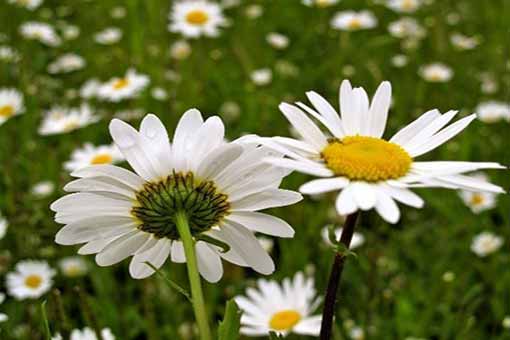
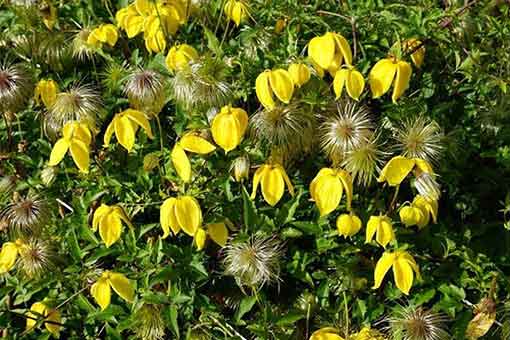

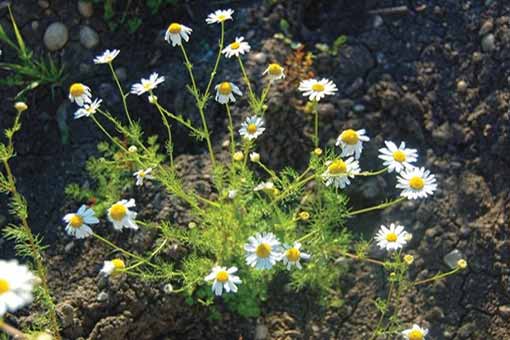
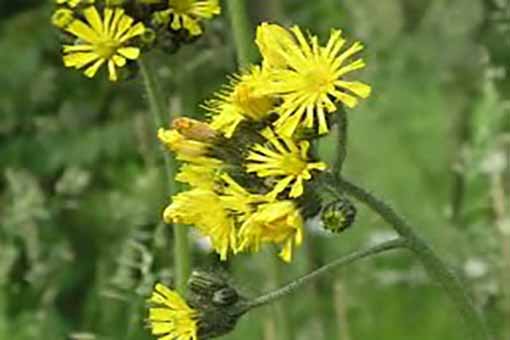
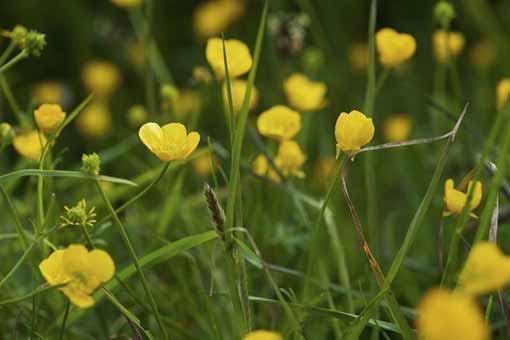
I’d like to use wood chips. Is this a good idea?
Firesmart Canada recommends that wood chips not be used. When landscaping against your home or building, consider using gravel mulch, rock mulch, or a combination of plant mulch and decorative rock mulch to reduce the risk. Wood chips are not considered vegetative and therefore not soft landscaping.
I’d like to plant a lawn. What seed mix should I use?
Jasper National Park encourages a movement away from standard lawns to more of a natural environment (rock gardens with natural grasses and natural flowers from our planting list). This approach blends nicely with the surrounding landscape can be used to meet Firesmart guidelines, takes little maintenance and discourages wildlife from entering your yard to forage.
Within the Jasper Townsite
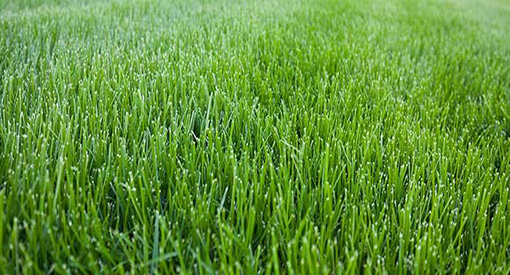
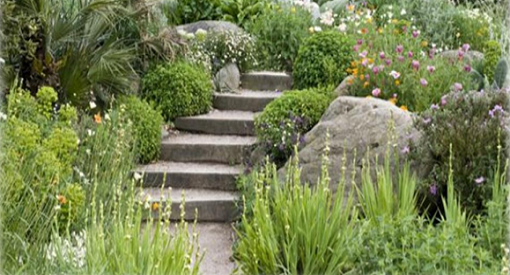
Where high-use public recreation areas require turf, high-quality non-native Kentucky Bluegrass/Creeping Red Fescue mixes similar to the following may be acceptable:
- 60 – 70% Kentucky Bluegrass selected, elite cultivars
- 20 – 30% “Boreal” Creeping Red Fescue
- 10 – 15% Perennial Ryegrass, turf-type cultivars
Outside of the Jasper Townsite
Choose from the provided grass species and combine at least three different grasses in your mix.
Can I place artificial turf in my yard?
The short answer is no. Here is why…
There are a few “soft” pros for artificial turf:
- It does not need to be cut.
- From a distance, it looks aesthetically pleasing.
- Turf does not need to be watered. This equals savings.
Points against artificial turf:
- Most artificial turf is made from polyethylene plastic, which is a petroleum-based product. This product needs to be replaced every 15 years, on average, and has a huge carbon footprint. Some of these plastics cannot be recycled — we don’t need more plastic in our environment.
- The soil underneath will be polluted for years to come.
- Artificial turf can be toxic to the environment and wildlife.
- Artificial turf does not absorb, filter or provide any benefits to water/hydrology.
The use of native grasses and plants require less water and have huge wildlife benefits—specifically for bees and butterflies. Native species do not require cutting and are beautiful. We simply need to get used to the new look.
- Date modified :